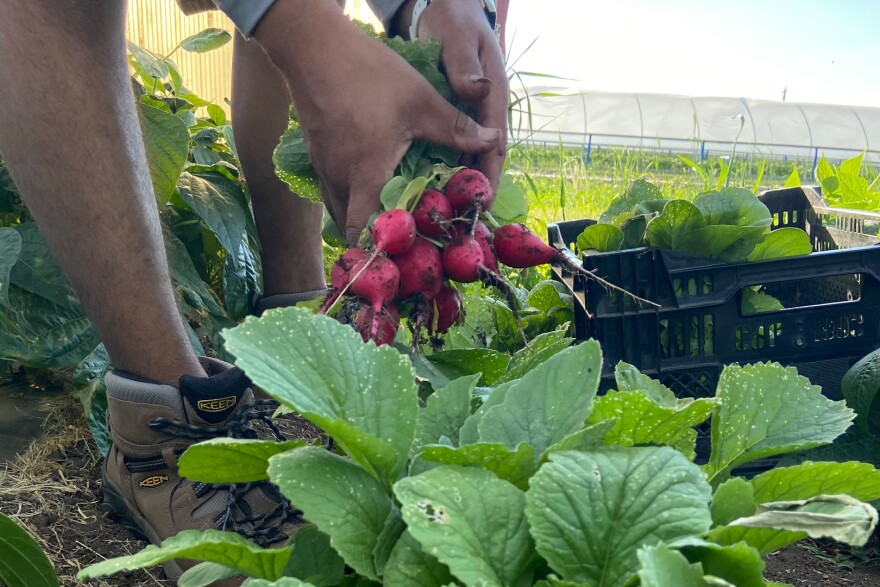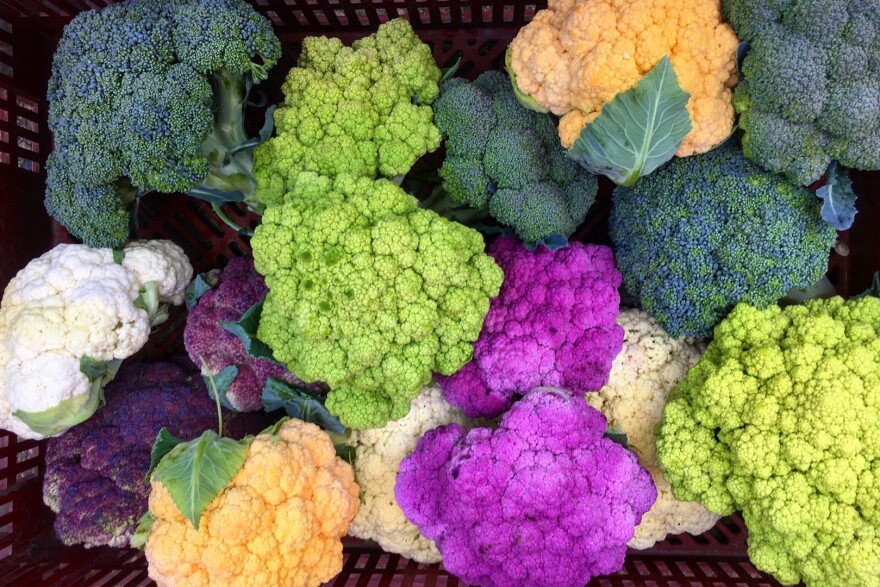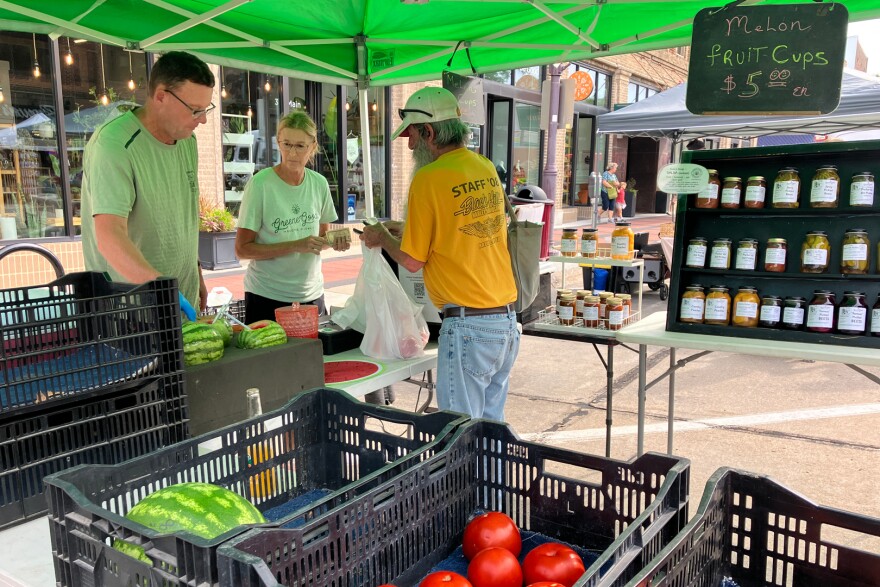At the Ames Main Street Farmers’ Market in central Iowa, Arlyn Goraczkowski zigzagged between vendors, filling bags with fresh produce. He opened one to reveal poblano peppers, garlic and leeks. Another was full of tomatoes and basil.
“I’ll use that for a fresh pasta. Then I got some carrots, eggplant, zucchini and yellow peppers, and that I’ll use for a succotash or something along that line,” he said.
Goraczkowski loves to cook with fresh produce. Along with what he grows in his own raised beds, he visits farmers’ markets around the state with his family to buy ingredients. They live in Fort Dodge, almost two hours northwest of Ames.
While the produce Goraczkowski bought is available at most grocery stores, he said it’s not the same as something locally-grown and picked fresh.
“I don’t mind spending the extra money on it because it’s better quality,” he said.

Not all local produce costs more – the price gap largely depends on the season and where someone buys groceries.
But generally it’s difficult for a produce farmer in the Midwest or Great Plains to compete with prices offered at Walmart or other large grocery chains.
Here's a look at the biggest factors that play a role in why local food often costs more.
Scale of operations
“The first thing that comes to mind is scale,” said Courtney Long, food systems program manager with Iowa State University Extension and director of the Agricultural Marketing Resource Center.
A commercial operation can more easily invest in equipment, infrastructure and technology to grow, harvest, wash, package and distribute their product in bulk, she said. For example, a large green bean operation may have machinery that harvests multiple rows at once.
“That helps with the efficiency side of the production,” Long explained.

In contrast, a small-scale farmer growing dozens of vegetables is likely hand-picking their green beans.
“And then you have the manual process of cleaning, of washing, of packaging – all of that is very time intensive,” Long said.
More time spent on each of these steps increases the labor costs.
Kevin Marshall is the owner-operator of Indigo Acres, a market garden farm north of Oklahoma City, where labor makes up about 70% of expenses.
“We're not really just hiring people to go pull weeds or run a tractor. We're hiring skilled labor that knows how to grow the plants,” Marshall said. “We have specialized tools. There’s a lot of training.”
Indigo Acres uses regenerative farming practices and grows food without chemicals, which is more labor-intensive. Marshall added that he needs to pay enough to ensure employees don’t quit when the temperature climbs above 100 degrees.

Zoami Sosa and her husband own Farmstand, a garden center in northern Iowa, and grow fruits and vegetables on a few acres an hour away with her sister and parents. They sell their produce at Farmstand and farmers’ markets in another Iowa town and Omaha, Nebraska.
“Sometimes we're more expensive [than grocery stores], but a lot of times we're really not. We're right on par, and then a lot of times we have discounts depending on the time of day," Sosa said.
She said they set prices based on what people are willing to pay, rather than the amount of labor they spend on the farm. If they did account for their hours, she said they’d be charging around $20 per pound of heirloom tomatoes rather than $4 per pound.
That doesn’t include other expenses, like transportation.
Transportation
Large produce operations also benefit from efficiencies of scale on the transportation side, said Michelle Miller, a senior researcher at the Center for Integrated Agricultural Systems at the University of Wisconsin.
“The two main costs in moving food are fuel and labor, and when you've got a full truckload, you're optimizing both those two components,” Miller said.
Before the 1970s, Miller said the distribution network was more regional than it is today, making it easier for small farms to sell products to wholesale markets.
But then fuel became more scarce and expensive during the oil crisis. Moving a full 53-foot truck across the country became cheaper than moving the same truck a shorter distance with less product and multiple stops, she explained.

“A lot of that regional distribution kind of died back, and we started depending on full truckloads moving from West Coast to East Coast or Mexico to Chicago to fill out distribution warehouses,” Miller said.
Food hubs, which aggregate and distribute products from farms, can help fill the gap, said Miller and Long. Many sell in bulk to retailers, schools and restaurants.
Before the Oklahoma City Food Hub formed in 2022, Marshall said Indigo Acres delivered produce to 10-15 buyers. Today, it’s just one drop at the food hub.
In Iowa, food hubs often coordinate to reduce the number of empty trucks driving across the state, Long said.
“If a north Iowa food hub has a client or a buyer in southern Iowa, they could drop off product in central Iowa, and a different food hub would help with that follow up delivery,” Long said. “That north Iowa food hub could backhaul and bring back product from a different location up north, as well.”
But hauling multiple products in one truck, and loading and unloading at several locations can quickly become logistically complicated, said Miller. Large companies have more capital to invest in technology to find the most efficient ways to move products.

Small, local farms aren’t just competing with bigger companies in the U.S.
Imports make up nearly 60% and 35% of the share of fresh fruits and vegetables respectively in the U.S. Between 2007 and 2003, the share of imported asparagus, avocados, bell peppers, blueberries, broccoli, cauliflower, cucumbers, raspberries, snap beans and tomatoes each increased by more than 20%.
Many of the countries that harvest, process and ship this produce have cheaper labor than the U.S.
And many also have longer growing seasons.
Shorter seasons
Miller said cold winters, especially in the Upper Midwest, can be a challenge for small-scale produce growers.
“Mexico can grow green beans all year round, whereas we can only grow them for one or maybe two crops in a year,” Miller said.
Grocery stores want a consistent supply of fresh produce to meet consumer demand. Large operations with a year-round growing season can charge less in the summer when produce is more abundant in northern latitudes and still make a profit over the course of the year, said Miller.

To extend the growing season, some farmers in the Midwest and Great Plains invest in indoor hydroponics, greenhouses and geodesic domes.
Marshall uses hoop houses, unheated plastic-covered structures that trap heat. During the summer, farmers can roll up the sides to let out hot air or cover them with shade cloth.
Tyler Raasch and his father have a dozen hoop houses at Bridgewater Farm, a 40-acre certified organic farm in southwest Iowa. He said they have over a dozen employees to grow vegetables and sell at seven farmers’ markets in Iowa and Nebraska.
They also sell produce through community supported agriculture (CSA) shares and to restaurants and grocery stores.
“Demand is growing every year, and it's just really hard to keep up with it,” Raasch said. “Generally, we haven't had too many problems with not getting enough for our produce or not selling the produce.”
Raasch said Bridgewater Farm’s prices are set primarily by market demand.
“The biggest factor, I would say, is how many other local farmers have the same things at the same time,” he said.

The high tunnels allow them to grow cold-hardy crops through the winter and get a head-start with certain types of produce. For example, they can harvest carrots, beets and broccoli in March instead of June and July.
Raasch said they also sell produce less common at the farmers’ markets they attend, like bok choy and mesclan greens.
Miller and Long see potential with new infrastructure to expand growing seasons, more processing and stronger distribution networks for local produce. This could open new markets, including wholesale, for small- and mid-scale farmers.
But from Long’s perspective, the emphasis should be increasing access, rather than making local food cheaper. Once someone fully understands why something costs more, she said they can decide whether it’s worth it.
Price vs. quality
Raasch, Marshall and Sosa said the hours they invest on their farms results in better care for their plants and higher quality produce.
For example, when Sosa’s family harvests green beans, she said they make multiple passes through the rows during the growing season to hand-select beans when they’re small and tender.

Selling produce within a few days of when it’s picked also affects quality. Fruits and vegetables can quickly lose nutrients after harvest, the degree to which depends on how they’re handled and stored.
Marshall said he spends a significant amount of time trying to explain to consumers why his produce has a higher price point than something they could buy at Walmart.
“It’s not the same product,” Marshall said. “It’s fresher. It hasn’t been shipped across 1,000 miles or 2,000 miles or across the ocean, so it has a higher nutrient density.”
Marshall and Raasch also strongly believe organic, fresh-picked produce and on-farm diversity are key to human and environmental health. They said their long-standing customers hold this view, as well.
“They also want to support the local economy because, by supporting the local economy, of course, we're supporting ourselves, because it just keeps circulating locally,” Raasch said.

Marshall added that empty grocery store shelves and a focus on health during the COVID-19 pandemic sparked more support for local food in Oklahoma. He said Indigo Acres and other farms in the region filled in gaps left by disrupted supply chains.
Marshall said support has cooled off in recent years, in part due to higher inflation. He emphasized that small-scale farmers need consistent support to stay in business. Otherwise, they may not be around for the next crisis.
Long-standing relationships with customers is one of the main reasons why Sosa continues to grow and sell local produce.
“Farmers markets only work if people around them are willing to support them. I think it's really important,” Sosa said.
Back at the farmers’ market in Ames, Melissa Chamberlin and Robert Hartman are ready to fill up their bags.
“We’ve been looking at the tomatoes, at peppers, cucumbers, zucchinis look pretty fresh at some of the stands,” Chamberlain said.
While price is something they consider when buying produce, she said it’s not the biggest factor. They like knowing the produce comes from local farms. They appreciate getting to know the vendors, and they feel like they’re part of the community when they shop at the market.
“For us, even if things are a little more expensive here than at the grocery store, we feel like it’s an entirely different experience being here,” she said.

This story was produced in partnership with Harvest Public Media, a collaboration of public media newsrooms in the Midwest and Great Plains. It reports on food systems, agriculture and rural issues.


